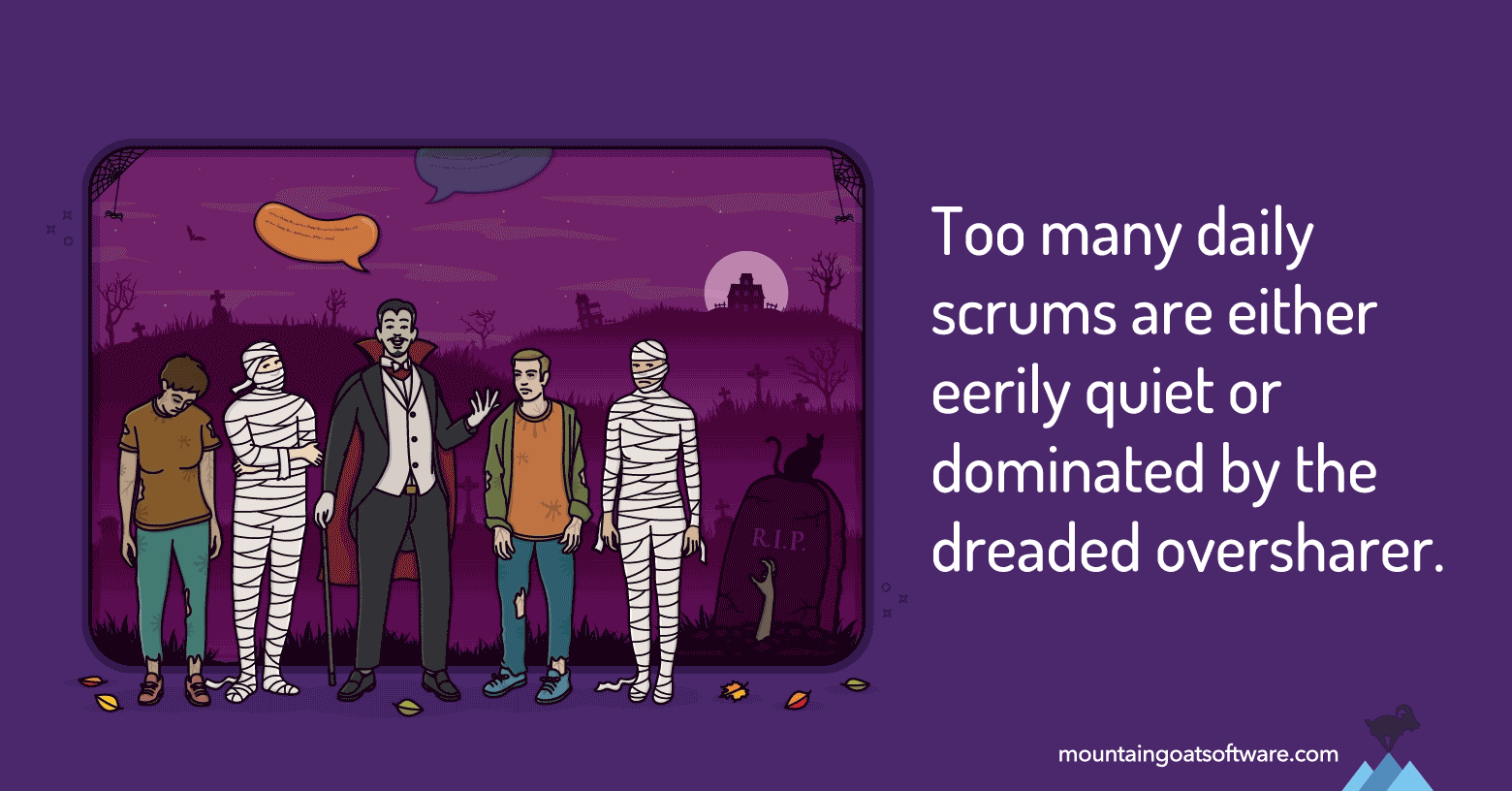The daily scrum is meant to be a brisk, fast-paced team synchronization meeting. They can quickly turn into the stuff of nightmares if people talk too little or too much. As Scrum Masters, our job is to facilitate daily scrums so that they achieve their purpose and stay within their timebox.
Two videos follow. And you might need to watch both, depending on your team! The first video introduces four things you can try to get the meeting moving when someone is dominating the conversation. The second video discusses things to try when certain people give vague answers (or fail to talk at all!). If you would prefer to read, a transcript follows each video.
Both will help you avoid two monsters of daily scrums: Time-sucking vampires and energy-killing zombies.
4 Things to Try When People Talk Too Much in Daily Scrums
Some people just won’t shut up. Maybe they’re nervous about something so they talk. Maybe they think everyone wants to hear their every thought. Maybe they’re not even aware they’re talking so much. But talking too much can be a huge problem, especially in a meeting with a short time box such as the daily scrum. Let’s see what you can do about it.
1. Set a Timer
A common solution to an overly talkative team member is for someone to start a one-minute timer as each person begins to give their update during the daily scrum. This is OK, but I find it often forces a team to finish too quickly. Someone’s update often would benefit from taking 2-3 minutes. That’s discouraged, though, with a one-minute timer on each person.
2. Make the Time Obvious
A Scrum Master, Kayleigh, taught me our second technique. As each person gives an update they hold a 3 kilogram, about 6-½ pounds, medicine ball straight out in front of them. The ball isn’t very heavy, but holding it straight in front of you will get harder the longer you talk. What I love about this technique is that it gets harder the longer you go. That makes it highly effective.
3. Interrupt Politely
Here’s a third tip for dealing with an overly talkative team member. Interrupt them, especially if you’re the Scrum Master or coach. We hesitate to interrupt because we think that would be rude. Instead, what’s rude is that person monopolizing the meeting with their soliloquy.
If someone is truly rambling on, the Scrum Master (or, really, anyone on the Scrum team) needs to interrupt them. Otherwise, it’s rude to everyone else in the meeting.
Here’s a good way to interrupt politely. Tell the speaker that it seems like they have more to say on this topic. Then add that everyone needs a chance to give their update within the prescribed 15-minute time box. Finally, offer to come back to the loquacious speaker after everyone has had a chance to share.
Some teams use the well-known idea of a parking lot for such topics. Just announce that you’re adding that item to the parking lot and will come back to it after everyone provides an update.
Other teams get a little more into the agile spirit of things and will refer to the parking lot as the “Sixteenth Minute.”
4. Create a Signal
If you find it hard to interrupt someone, here’s a technique that will help. Instead of actually interrupting the person, give team members a way of politely signaling the person they’ve gone on too long. Think about Academy Award acceptance speeches. Talk too long and the orchestra starts playing. Keep talking and they play louder.
A fun way to achieve the same effect is with Elmo, the Sesame Street character. Then use his name as an acronym–Enough, Let’s Move On. If you’re all in person, buy a stuffed Elmo and have it in your meeting room. Anyone can hold up the stuffed Elmo if they think someone is rambling. It works even better for video meetings. Encourage everyone to find their favorite Elmo background and pull it up when someone talks too long.
Daily scrums are meant to be brisk, fast-paced meetings. I don’t want a typical team to finish in 5 minutes. That’s almost certainly too short for anything meaningful to have been discussed or shared.
But I also don’t want the meeting to go too long, and I certainly don’t want one person to monopolize the conversation.
4 Things to Try When People Don’t Talk in Daily Scrums
Let’s talk now about not talking. How do you get someone to speak up in a daily scrum?
I don’t mind if someone is silent in a meeting when they don’t have anything to contribute. That’s fine, and it’s to be commended over the behavior of someone who feels compelled to chime in on everything.
But, being silent in a daily standup is a problem because each person is expected to contribute.
For years, daily scrum (or daily standup) meetings followed the same format. Each participant was expected to say what they had done since the prior meeting, what they’d do before the next meeting, and to describe anything impeding their progress. Those three items represented a person’s progress, plans, and problems.
Those three items are no longer required of a Scrum team in its daily scrums. They remain a good default option for most teams in what should be covered in the meeting. But how you get to the progress, plans, and problems isn't set in stone. You should mix it up a bit, especially if your daily scrums aren't working. I recommend going story by story, instead of person by person.
But what should you do if you’re a Scrum Master or coach with team members who give an update but don’t say anything meaningful? Something like, “Yesterday, I worked on a few tasks. Today I’ll work on a few tasks. No blockers.”
I’ve heard essentially that too many times to count. And it’s worthless.
1. Probe for Specifics
When someone gives an update like this, you need to push them on specifics. If they say merely that they “worked on some tasks,” have them name the specific tasks. Or if you’re physically together with a task board on kanban, have them point to the specific rows or cards.
2. Return to Structure
Additionally, ask people who give vague updates one question at a time. If your team follows the convention of talking about progress, plans and problems, ask first just about progress.
Don’t let this person tell you about all three aspects of their work. If they start shifting into plans or problems, bring them back to progress first. Say something like, “That’s great, and we’ll all want to hear more in a minute about your plan for today, but which specific tasks did you work on yesterday?” Bring them back to the one topic.
Often someone who gives a vague update like saying they worked on some tasks is an introvert. And I can relate: so am I. But something worth knowing about introverts is that while we may dread small talk, most of us do OK with structured conversations. So, reinforce the structure of these meetings.
If you want people to cover progress, plans and problems, emphasize that structure by asking about each in turn.
I’m actually not a big fan of a Scrum Master or coach calling on people and asking questions in this way. I’d prefer to let a team self organize in how they go about the meeting. But with quiet individuals, bring back some structure. It will help the introverts on the team.
3. Encourage an Order
Another way to add structure to the meeting is to have people give their updates in a known order. And consider having the quiet, vague team members go first. Or you may even go first yourself. (Yes: I think Scrum Masters and coaches should give updates, too.)
A good way to do that is to start with something like, “OK, let’s hear from Ajay first and then Astrid, but I’ll start us out.” Then give your update, which gives the person or two you named a chance to prepare their update.
Why do I like to start with the folks who give vague updates? Because otherwise they’re nervous throughout the meeting that they’ll be called on next. It’s better to let them know when they’ll go. And you going first gives them a moment to collect their thoughts.
4. Reinforce the Purpose
Another step you can take is to reinforce the purpose of daily standup meetings. They aren’t to micromanage a team. Daily scrums aren’t status meetings designed to check up on people. They’re synchronization meetings. Team members are synchronizing effort to make sure nothing important is being overlooked and two people aren’t doing the same thing without being aware of each other.
When people know the purpose of a meeting, they’re more likely to understand the right way to participate, by not talking too much or too little, but just enough!
These are just some of many ways to create more effective daily scrums for your teams.
Last update: November 5th, 2025








